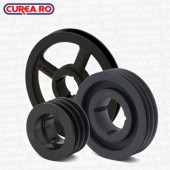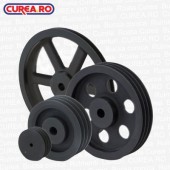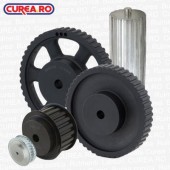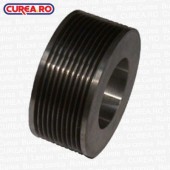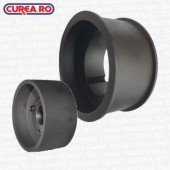Pulleys
General information
V-belts are used in the pulley with a groove. Without a V-belt, the V-belt cannot be used. The V-belt is tensioned into the trapezoidal groove milled into the pulley mantle, so even with a higher normal force, the force on the shaft does not increase too much. Standard V-belt pulleys can be made using several fastening methods. The most common is the basic drilled V-pulley, which is also called a pre-drilled pulley and a holeless pulley. This product requires machining.
General information
V-belts are used in the pulley with a groove. Without a V-belt, the V-belt cannot be used. The V-belt is tensioned into the trapezoidal groove milled into the pulley mantle, so even with a higher normal force, the force on the shaft does not increase too much. Standard V-belt pulleys can be made using several fastening methods. The most common is the basic drilled V-pulley, which is also called a pre-drilled pulley and a holeless pulley. This product requires machining.
A tapered clamping pulley is also very common, which does not require machining, because from the tapered clamping that fits inside the disc, variants with holes suitable for all kinds of shafts can be selected. These products can be found in our assortment. If you are looking for a pulley with a different mounting system, please contact us at our contact details or via the Contact form. Pulleys, toothed pulleys, Poly-V pulleys are specially designed to accommodate flat, rack and pinion belts (of the same marking) corresponding to their type. It is not recommended to use flat, ribbed and toothed belts on pulleys other than their type, as this can drastically reduce their service life! The toothed belt pulley is the driving element of toothed belts (cross-ribbed belts). Its teeth are specially adapted to the division and profile of different toothed belts. They are usually made of steel or aluminum, but very large ones can also be made of cast iron. There are both rimmed and rimless versions, and even a separate rim is available. They are made in fixed widths, but a disc of individual width can also be formed from a rack and pinion. The flat belt pulley is suitable for driving flat belts of various thicknesses. A common feature is the barrel design, which is responsible for the tension of the belt. As a rule, they are made of casting. There are both rimmed and rimless versions. They are made in fixed widths. The longitudinal pulley is the active element of longitudinal belts. Its advantage is that they can transmit high torque even over small diameters. The fins on the pulley correspond exactly to their respective belt profile and are not interchangeable. They contain a fixed number of ribs, a belt narrower than the number of ribs on the disc can be used, but a wider belt, i.e. with more ribs, cannot be used on a pulley with that rib.
A tapered clamping pulley is also very common, which does not require machining, because from the tapered clamping that fits inside the disc, variants with holes suitable for all kinds of shafts can be selected. These products can be found in our assortment. If you are looking for a pulley with a different mounting system, please contact us at our contact details or via the Contact form. Pulleys, toothed pulleys, Poly-V pulleys are specially designed to accommodate flat, rack and pinion belts (of the same marking) corresponding to their type. It is not recommended to use flat, ribbed and toothed belts on pulleys other than their type, as this can drastically reduce their service life! The toothed belt pulley is the driving element of toothed belts (cross-ribbed belts). Its teeth are specially adapted to the division and profile of different toothed belts. They are usually made of steel or aluminum, but very large ones can also be made of cast iron. There are both rimmed and rimless versions, and even a separate rim is available. They are made in fixed widths, but a disc of individual width can also be formed from a rack and pinion. The flat belt pulley is suitable for driving flat belts of various thicknesses. A common feature is the barrel design, which is responsible for the tension of the belt. As a rule, they are made of casting. There are both rimmed and rimless versions. They are made in fixed widths. The longitudinal pulley is the active element of longitudinal belts. Its advantage is that they can transmit high torque even over small diameters. The fins on the pulley correspond exactly to their respective belt profile and are not interchangeable. They contain a fixed number of ribs, a belt narrower than the number of ribs on the disc can be used, but a wider belt, i.e. with more ribs, cannot be used on a pulley with that rib.
News
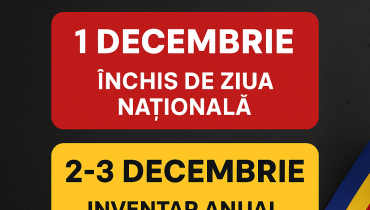 INVENTAR ANUAL
1 Decembrie - Ziua națională a României
2-3 Decembrie - inventar anual
⏰ În cazul comenzilor plasate în această perioadă, data preconizată de livrare va apărea incorect în mail-ul de confirmare trimisă automat despre comanda. (Termenul limită de livrare va fi amânat)
Mulțumim pentru înțelegere!
next
INVENTAR ANUAL
1 Decembrie - Ziua națională a României
2-3 Decembrie - inventar anual
⏰ În cazul comenzilor plasate în această perioadă, data preconizată de livrare va apărea incorect în mail-ul de confirmare trimisă automat despre comanda. (Termenul limită de livrare va fi amânat)
Mulțumim pentru înțelegere!
next
 De ce nu putem identifica majoritatea curelelor trapezoidale pentru tractoare de tuns gazon dupa tipul de mașină?
Obiectivul producătorilor de mașini este, în general, acela de a se asigura că prețul de vânzare al pieselor de schimb pentru mașinile pe care le comercializează acoperă costurile de furnizare a pieselor și, dacă este posibil, să genereze un profit. Ei pot face acest lucru prin a nu eticheta piesele standard utilizate în mașină cu denumirile lor standard, ci prin utilizarea unor identificatori unici și numere de piese care au sens doar pentru specialiștii familiarizați cu produsul.
next
De ce nu putem identifica majoritatea curelelor trapezoidale pentru tractoare de tuns gazon dupa tipul de mașină?
Obiectivul producătorilor de mașini este, în general, acela de a se asigura că prețul de vânzare al pieselor de schimb pentru mașinile pe care le comercializează acoperă costurile de furnizare a pieselor și, dacă este posibil, să genereze un profit. Ei pot face acest lucru prin a nu eticheta piesele standard utilizate în mașină cu denumirile lor standard, ci prin utilizarea unor identificatori unici și numere de piese care au sens doar pentru specialiștii familiarizați cu produsul.
next
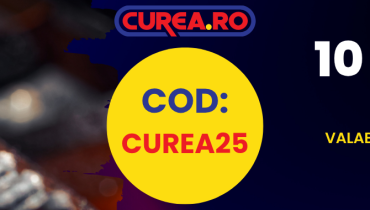 CUPON PROMOȚIE 10 RON
Comandă de cel puțin 130 Ron , folosește codul de cupon: CUREA25 , și ai reducere 10 RON
next
CUPON PROMOȚIE 10 RON
Comandă de cel puțin 130 Ron , folosește codul de cupon: CUREA25 , și ai reducere 10 RON
next
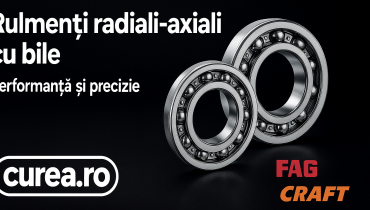 Rulmenții radiali-axiali cu bile – performanță, precizie și durabilitate
Într-un mediu industrial tot mai competitiv, alegerea unor rulmenți cu bile și rulmenți radiali de calitate este o investiție în durabilitate, eficiență și performanță. Brandurile FAG și CRAFT, disponibile pe curea.ro
next
Rulmenții radiali-axiali cu bile – performanță, precizie și durabilitate
Într-un mediu industrial tot mai competitiv, alegerea unor rulmenți cu bile și rulmenți radiali de calitate este o investiție în durabilitate, eficiență și performanță. Brandurile FAG și CRAFT, disponibile pe curea.ro
next
